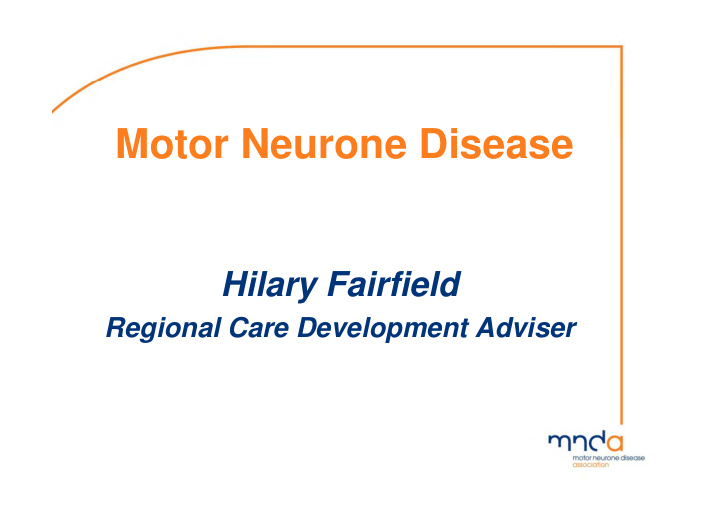



Motor Neurone Disease Motor Neurone Disease Hilary Fairfield Regional Care Development Adviser
“Motor Neurone Disease” Refers to a group of neurological diseases that selectively affect motor neurones • Amyotrophic Lateral Sclerosis (ALS) • Progressive Bulbar Palsy (PBP) Progressive Bulbar Palsy (PBP) • Progressive Muscular Atrophy (PMA) • Primary Lateral Sclerosis (PLS)
Key facts and figures •Terminal disease •Adult illness •Adult illness – most people are over 50 most people are over 50 •Male:female 3:2 •Incidence is 2 per 100,000 I id i 2 100 000 •Prevalence is 7 per 100,000 •Onset and progression is variable •90 – 95% have the sporadic form 90 95% have the sporadic form
Symptoms
Features at onset of MND
Clinical features of MND
Clinical features of MND
MND: A multifactorial disease Environmental Genetic Lifestyle/Occupation Susceptibility genes Age NF-H VEGF VEGF Gender Gender PER Diet? • • ELP3 Toxins (eg BMAA)? • UNC13A EMFs/Electric Shock? PON Athleticism? • • ATXN2 • Military Service? Military Service? • • • ZNF512B ZNF512B Infection? SigmaR1 C9orf72
Familial MND: A genetic disease Familial MND: A genetic disease Ang (2006) TDP-43 (2008) FUS (2009) DAO (2010) EphA4 OPTN (2010) KIFAP3 • • • VCP (2010) • • • SOD1 • SOD1 (1993) UBQLN2 (2011) C9orf72 (2011 ) • • • • • SQSTM1 (2011) • ( ) PFN1 (2012) hnRNPA1 (2013) Gene X (2014)
Rate of gene discovery is increasing: ~ 30 ALS genes involved in ALS HNRNPA1 HNRNPA1 HNRNPA2B1 PFN1 CREST UQLN1 TAF15 TAF15 p62 EphA4 C9orf72 OPTN SIGR1 UQ:N2 ATXN2 ATXN2 VCP DAO FUS PON1-3 KIFAP3 KIFAP3 ELP3 CHGB ANG DCTN1 UNC13A U C 3 TDP43 SOD1 SETX NTE alsin VAPB Courtesy of RH Brown Jr
“There is more going on in MND research now than at any other time. I find huge inspiration in the knowledge that when I finish my work for the day, the MND researchers in Australia are just beginning theirs” Martin Turner 2000 ALS/MND 1800 1600 entries Huntington's Disease 1400 PubMed e 1200 Progressive Supranuclear Palsy 1000 800 800 600 400 200 0 Courtesy of Martin Turner and Deanna Packham
Progressive Bulbar Palsy
Progressive Muscular Atrophy
Treatments/interventions in MND
Multidisciplinary approach
Needs of people living with MND
Improving MND Care survey 2013 B t Between 2009 and 2013, there were improvements in: 2009 d 2013 th i t i • the experience of getting a diagnosis (eg. people f ( having tests explained to them, the opportunity to ask questions and being given the news in a private questions and being given the news in a private place) • the number of people who have a named person co- ordinating their care. In 2013, 78% (n=718) had a g , ( ) named person co-ordinating their care.
Improving MND Care survey 2013 B Between 2009 and 2013, there were 2009 d 2013 h improvements in: • People’s ability to access and receive support p y pp with their breathing • In 2009, 13% of respondents used NIV, compared to 28% of respondents in 2013 compared to 28% of respondents in 2013.
“Is your breathing monitored and “I b thi it d d assessed?” (n=913)
“Wh t “What special help do you have with your i l h l d h ith breathing?” (n=779)
“Have you been offered any information about your choices and options at the end of your life?” (n=589)
“What does having control at the end of life “Wh t d h i t l t th d f lif mean to you?” (n= 557)
Principles underpinning the Model of Care Care
Hilary Fairfield Regional Care Development Adviser Regional Care Development Adviser West of England Telephone 0845 375 1828 Email hilary.fairfield@mndassociation.org Website www.mndassociation.org Website www.mndassociation.org
Recommend
More recommend